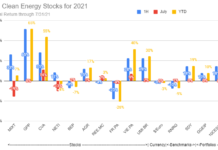Garvin Jabusch
In search of a sucessor to the Global Industry Classification Standard
The Global Industry Classification Standard (GICS) is the framework within which finance types organize companies and their stocks into industries and sectors. You’ve heard the names for these groups many times: energy, transportation, materials, commercial services, etc. These divisions have been useful in attempting “to enhance the investment research and asset management process for financial professionals worldwide” (mscibarra.com, 3/2010). And, for a while, GICS did a decent job of keeping portfolio managers, investment advisors and their clients reasonably well organized in their thinking about diversification and risk.
But that was then.
GICS was created by S&P and MSCI Barra to reflect their indices (such as the S&P 500), but, since these indices are largely comprised of companies created during the late 19th- and 20th-century economies, GICS, perhaps understandably, defines energy essentially as “burning something to get power.” There are other legacy issues with GICS as well but, for now, I’ll focus on energy.
Here at Green Alpha ® Advisors, in addition to managing the Sierra Club Green Alpha Portfolio, we manage a Next Economy (green) index of public equities we call the Green Alpha Next Economy Index or GANEX. Take a look at our old GICS based sector weights in this table:
Green Alpha Advisors ® Next Economy Index, GICS based sectors, 12/31/10
| GICS Sector | Average Weight | |
| CONSUMER DISCRETIONARY | 15.97 | |
| CONSUMER STAPLES | 9.97 | |
| ENERGY | ||
| FINANCIALS | ||
| HEALTH CARE | 0.91 | |
| INDUSTRIALS | 28.75 | |
| INFORMATION TECHNOLOGY | 30.39 | |
| MATERIALS | 11.62 | |
| TELECOMMUNICATION SERVICES | 0.09 | |
| UTILITIES | 2.29 | |
These are important because the way GICS forces us to classify our holdings is pure 19th century. Notice there’s nothing in our energy sector. Our published top 25 holdings as of 12/31/2010 included such names as First Solar, Inc. (FSLR), and Vestas Wind Systems (VWDRY.PK). And the unpublished part of the portfolio contains many more companies in solar, wind, wave, turbine, and geothermal power. Yet, according to GICS, we have no exposure to the energy sector at all. None. All our power-related holdings fall under either “industrials” or “information technology.” Really? I get how some of these could be manufacturing but, come on, these days there’s so much more to power than burning fossilized hydrocarbons. (In addition, this skewing of reality means the “industrials” and “information technology” sectors in our index now appear more weighted than they really are.)
So, for a next-economy index, using GICS sectors actually misrepresents portfolio characteristics, completely contrary to the stated goals of the GICS. Some portfolio managers have addressed this problem by artificially classifying their renewable energy holdings under “Oil and Gas.” This approach makes it clear that there is energy representation in a portfolio, but it’s clearly a temporary fix for a deeper, structural problem.
We launched the Green Alpha Next Economy Index (GANEX) largely because there was no economy-wide, cross-sector, cross-industry, all cap index that reflected the true state of what we call the “next,” or eco-efficient economy. There was no way to accurately measure the alpha (outperformance) of a green portfolio, because there was no systemic beta (recognized representation of the green economy as a whole). Before we founded Green Alpha Advisors, during the years we ran the Sierra Club Stock Fund (a large cap green portfolio), we had to benchmark ourselves against the S&P 500. And for most of our tenure there, we did outperform that index. But the question was put to us again and again by institutional prospects: “Okay, you’re beating the S&P 500, but what about other green portfolios? What about performance versus a benchmark that isn’t overrun with hydrocarbons and legacy manufacturing?” It’s a good question and it ultimately led to the genesis of our firm and the GANEX. The GANEX, in turn, can and does serve as an indicator of the performance and progress of the next economy.
So, when it came time to present a sector breakdown for our portfolios, we found ourselves in the familiar place of having no way to accurately compare our portfolio to the world at large. We were stuck using legacy tools in a new world. Put simply, GICS regards “energy” as the combustion of oil, coal, and natural gas, and subsequently its schema lacks accuracy and depth. So, in addition to attempting to define the next economy with our index, we now find ourselves needing to define new sectors by which the new economy (and energy in particular) can be better evaluated.
It’s time to move on, so, presented herewith: our first shot, back-of-the-bar-napkin attempt at a new paradigm: New sectors, next-economy classification.
|
CATEGORY |
DESCRIPTION |
EXAMPLES |
|
Energy |
|
|
|
Legacy Energy |
|
|
|
Resources |
|
|
|
Materials |
|
|
|
Infrastructure |
|
|
|
Objects |
|
|
|
Services |
|
|
Clearly this has to be developed further, notably with a lot of subgroups. But we think it’s a good first step toward reflecting the next economy as it is and as it will become. We also like to think it’s a little closer to plain English than the current system and can therefore help demystify finance and close the gap between advisor and client.
Garvin Jabusch is the cofounder of Green Alpha Advisors, LLC and manages The Sierra Club Green Alpha Portfolio a unique blend of Green Alpha Advisors’ Next Economy universe and the Sierra Club’s proprietary green-investment guidelines.









Interesting – I was getting worried that my portfolio was primarily industrials and IT – thanks for sharing this interesting perspective.